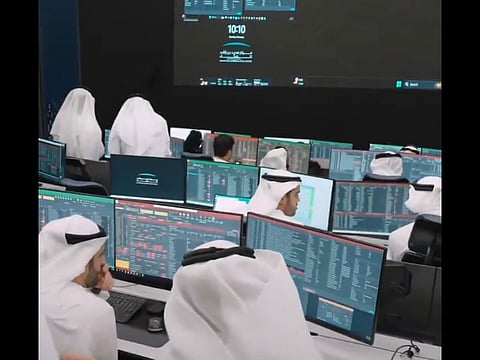Watch: UAE’s MBZ-SAT sends first signal from low Earth orbit
MBRSC Dubai confirms beginning of region’s most advanced satellite’s mission

Dubai: The Mohammed Bin Rashid Space Centre (MBRSC) in Dubai on Wednesday announced successfully receiving the first signal from MBZ-SAT, the region’s most advanced satellite, following its launch into low Earth orbit on Tuesday night.
The space centre confirmed that all systems of the satellite, named in honour of the President His Highness Sheikh Mohamed bin Zayed Al Nahyan, are operating efficiently.
“The region’s most advanced satellite has commenced its mission to deliver data supporting global development,” MBRSC said on social media, confirming the successful deployment of the 750kg satellite.
MBZ-SAT delivers twice the image resolution, 10 times more images, and data transmission speeds four times faster than current systems.
The satellite’s successful deployment represents a significant milestone for the UAE’s space programme, reaffirming the country’s commitment to advancing technological innovation and contributing to global progress.
The UAE on Tuesday night launched three satellites including MBZ-SAT, scripting new history in its space exploration.
Celebrating the launch
There have been nationwide celebrations to mark the launch of MBZ-SAT. Landmark buildings in Abu Dhabi and the world’s tallest tower Burj Khalifa in Dubai, lit up to celebrate the launch of the satellite with the tag “Made in the Emirates.”
On Wednesday, the General Directorate of Residency and Foreign Affairs (GDRFA) in Dubai welcomed visitors to the UAE arriving at Dubai Airports with a special MBZ-SAT stamp to mark the launch. GDRFA posted images of the logo of the satellite mission on the passports of passengers on social media, adding that it was to pay tribute to the launch of the satellite that reflects the UAE's achievement in space and the visionary leadership's ambitious vision.
Meanwhile, several display boards on streets and important buildings also showcased the launch details.
Where is MBZ-SAT now?
MBZ-SAT was launched into space on board a Falcon 9 rocket of Elon Musk’s SpaceX from Space Launch Complex 4E (SLC-4E) at the Vandenberg Space Force Base in California, along with two student-built CubeSats—HCT-SAT 1 and Al Ain SAT 1.
The massive Earth observation satellite was launched into low Earth Sun-Synchronous Orbit (SSO) which is 500 to 550km away from Earth.
A low Earth Sun-synchronous orbit (SSO) is an orbit in which a satellite has the same position relative to the Sun and thus passes over the same region of Earth at the same time every day. This allows for the study of changes to a specific area of Earth over time.
MBZ-SAT is designed to deliver high-resolution data to support global development initiatives. Its state-of-the-art capabilities are expected to enhance various sectors, including environmental monitoring, urban planning, and disaster management.
After becoming operational in its orbit, the second Emirati-built Earth observation satellite is now being managed from the brand new Mission Control Centre at MBRSC, with teams monitoring its operations and analysing data transmitted back to Earth.
When will it send first image?
“The first (official) image depends on when we are going to finish the testing and the verification,” Adnan Al Rais, Assistant Director General, Space Operations and Exploration Sector, MBRSC, told Gulf News from the Mission Control Centre of MBRSC..
“It might take days or weeks. It depends, but the normal images that will be provided with end users should go through the complete calibration process that will take around three months. Then after that, the data will be available to our end users and the different government departments and also different partners to use the data and the images from MBZ-SAT,” he added.
Historic achievement
Meanwhile, Hamad Obaid Al Mansoori, Chairman, MBRSC said the launch of MBZ-SAT is a historic achievement reflecting the leading position of the Emirati space sector. “(The launch) confirms the leading position achieved by our space sector following the vision of our wise leadership. It is a historic achievement for our team of over 200 experts who developed the satellite and the Emirati companies that contributed towards its development,” he pointed out.
Salem Humaid Al Marri, Director General, MBRSC, expresses his pride of being in the team who worked on MBZ-SAT.
“Proud of launching MBZ-SAT, the most advanced satellite in the region, and the great efforts of our colleagues and companies from the UAE. We convey our gratitude to our wise leadership for their unwavering support. Now the mission begins in space, as we start to receive data and imagery to serve developmental efforts,” he stated.
Al Mansoori and Al Marri were among the top officials present in California to witness the launch. Also present at the launch were astronaut Dr Sultan Al Neyadi, who is also the Minister of State for Youth Affairs, along with Yousuf Hamad Al Shaibani, Vice Chairman, Salem Butti Al Qubaisi, Director General, UAE Space Agency, and Amer Al Sayegh Al Ghaferi, Project Manager, MBZ-SAT.
AI, automated software
MBZ-SAT uses an automated software, reducing human intervention by running scripts that collect and analyse telemetry data. These scripts can detect abnormalities, if any, and can alert engineering teams. Additionally, Artificial Intelligence will be used to analyse large amounts of data collected over time.
It is the most advanced commercial satellite in the region that will provide unprecedented high-resolution images and rapidly deliver data to users worldwide through an automated, 24/7 imaging system.
It will provide detailed images for various applications including environmental monitoring, navigation, infrastructure management, and disaster relief, significantly aiding in the assessment and response to natural calamities.
MBZ-SAT will have double the image capture accuracy, four times faster data transfer speeds and produce 10 times more images than current capabilities, thanks to its automated scheduling and processing system. It can take extremely close-up images with every pixel covering less than 30cm.
Sign up for the Daily Briefing
Get the latest news and updates straight to your inbox



